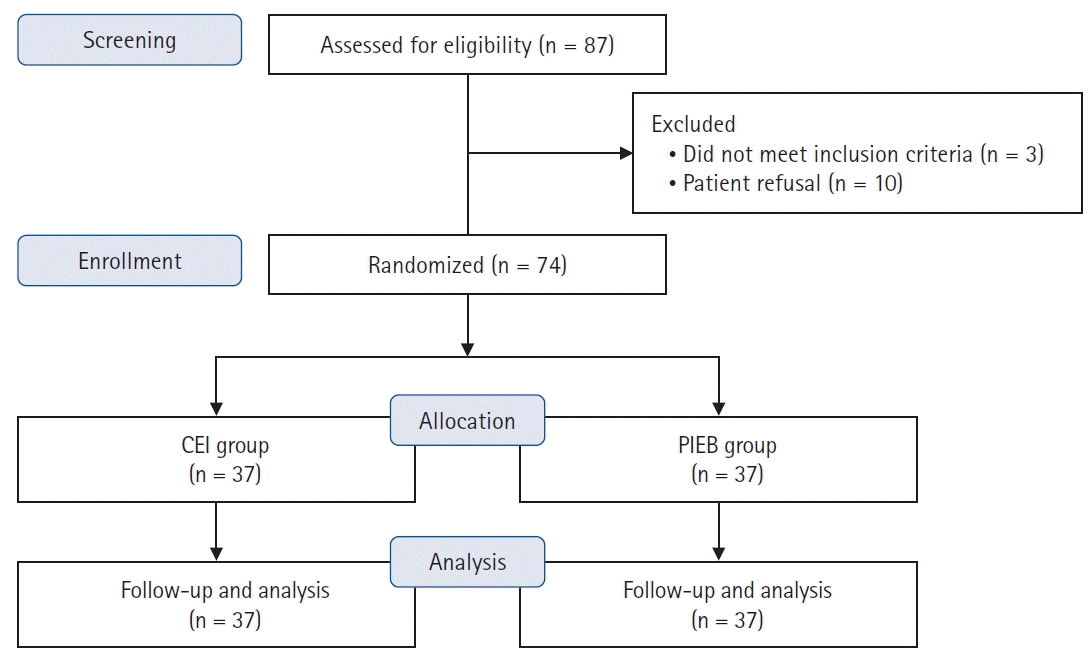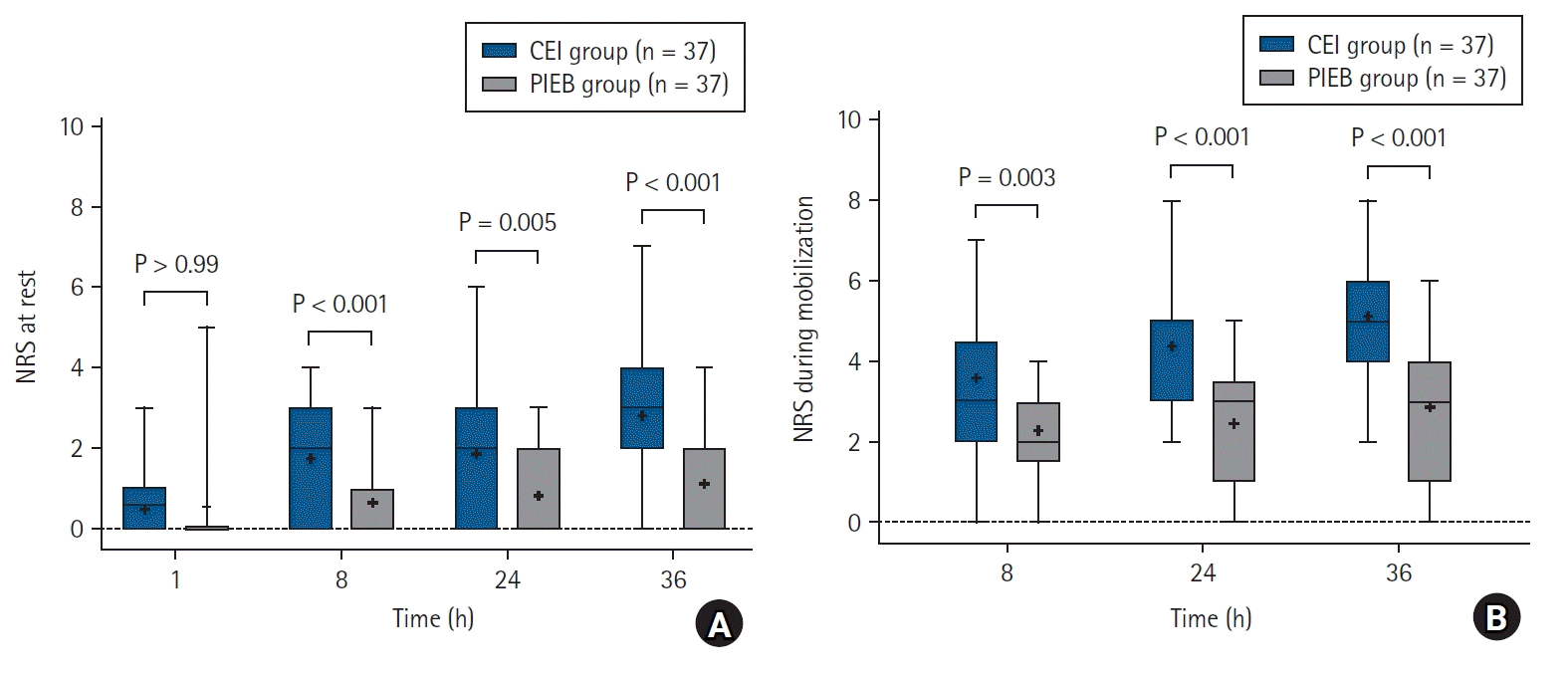1. Boerma T, Ronsmans C, Melesse DY, Barros AJ, Barros FC, Juan L, et al. Global epidemiology of use of and disparities in caesarean sections. Lancet. 2018; 392:1341–8.

2. Niklasson B, Georgsson Ohman S, Segerdahl M, Blanck A. Risk factors for persistent pain and its influence on maternal wellbeing after cesarean section. Acta Obstet Gynecol Scand. 2015; 94:622–8.

3. Babazade R, Vadhera RB, Krishnamurthy P, Varma A, Doulatram G, Saade GR, et al. Acute postcesarean pain is associated with in-hospital exclusive breastfeeding, length of stay and post-partum depression. J Clin Anesth. 2020; 62:109697.

4. Guevara J, Carvalho JC, Downey K, Ye XY, Sharkey AM, Arzola C. Predicting pain after Cesarean delivery: pressure algometry, temporal summation, three-item questionnaire. Can J Anaesth. 2021; 68:1802–10.

5. Bullingham A, Liang S, Edmonds E, Mathur S, Sharma S. Continuous epidural infusion vs programmed intermittent epidural bolus for labour analgesia: a prospective, controlled, before-and-after cohort study of labour outcomes. Br J Anaesth. 2018; 121:432–7.

6. Ojo OA, Mehdiratta JE, Gamez BH, Hunting J, Habib AS. Comparison of programmed intermittent epidural boluses with continuous epidural infusion for the maintenance of labor analgesia: a randomized, controlled, double-blind study. Anesth Analg. 2020; 130:426–35.

7. Hussain N, Lagnese CM, Hayes B, Kumar N, Weaver TE, Essandoh MK, et al. Comparative analgesic efficacy and safety of intermittent local anaesthetic epidural bolus for labour: a systematic review and meta-analysis. Br J Anaesth. 2020; 125:560–79.

8. Mo X, Zhao T, Chen J, Li X, Liu J, Xu C, et al. Programmed intermittent epidural bolus in comparison with continuous epidural infusion for uterine contraction pain relief after cesarean section: a randomized, double-blind clinical trial. Drug Des Devel Ther. 2022; 16:999–1009.

9. Wang L, Wu Z, Hu L, Wang Y. Programmed intermittent epidural bolus for post-cesarean delivery analgesia: a randomized controlled double-blind trial. J Anesth. 2022; 36:32–7.

10. Bang YJ, Lee EK, Kang R, Kim AH, Kim CS, Sim WS, et al. Effect of chewing gum on anxiety in women undergoing elective cesarean section: a randomized controlled study. Ann Palliat Med. 2023; 12:529–37.

11. Kim D, Kim J, Choo H, Choi DH. Programmed intermittent epidural bolus as an ideal method for labor analgesia: a randomized controlled trial. Korean J Anesthesiol. 2024; 77:106–14.

12. Graham AC, McClure JH. Quantitative assessment of motor block in labouring women receiving epidural analgesia. Anaesthesia. 2001; 56:470–6.

13. Kang R, Lee S, Lee E, Cho YJ, Jeong JS, Choi SJ, et al. Validation and clinical utility of the Korean version of the Obstetric Quality-of-Recovery Score (ObsQoR-11) following elective cesarean section: a prospective observational cohort study. Diagnostics (Basel). 2022; 12:291.

14. Laigaard J, Pedersen C, Rønsbo TN, Mathiesen O, Karlsen AP. Minimal clinically important differences in randomised clinical trials on pain management after total hip and knee arthroplasty: a systematic review. Br J Anaesth. 2021; 126:1029–37.

15. Klumpner TT, Lange EM, Ahmed HS, Fitzgerald PC, Wong CA, Toledo P. An in vitro evaluation of the pressure generated during programmed intermittent epidural bolus injection at varying infusion delivery speeds. J Clin Anesth. 2016; 34:632–7.

16. Carvalho B, George RB, Cobb B, McKenzie C, Riley ET. Implementation of programmed intermittent epidural bolus for the maintenance of labor analgesia. Anesth Analg. 2016; 123:965–71.

17. Hogan Q. Distribution of solution in the epidural space: Examination by cryomicrotome section. Reg Anesth Pain Med. 2002; 27:150–6.

18. Mowat I, Tang R, Vaghadia H, Krebs C, Henderson WR, Sawka A. Epidural distribution of dye administered via an epidural catheter in a porcine model. Br J Anaesth. 2016; 116:277–81.

19. Cole J, Hughey S. Bolus epidural infusion improves spread compared with continuous infusion in a cadaveric porcine spine model. Reg Anesth Pain Med. 2019; 44:1080–3.

20. Lange EM, Wong CA, Fitzgerald PC, Davila WF, Rao S, McCarthy RJ, et al. Effect of epidural infusion bolus delivery rate on the duration of labor analgesia: a randomized clinical trial. Anesthesiology. 2018; 128:745–53.

21. Capogna G, Camorcia M, Stirparo S, Farcomeni A. Programmed intermittent epidural bolus versus continuous epidural infusion for labor analgesia: the effects on maternal motor function and labor outcome. a randomized double-blind study in nulliparous women. Anesth Analg. 2011; 113:826–31.
22. Macones GA, Caughey AB, Wood SL, Wrench IJ, Huang J, Norman M, et al. Guidelines for postoperative care in cesarean delivery: Enhanced Recovery After Surgery (ERAS) Society recommendations (part 3). Am J Obstet Gynecol. 2019; 221:247.

23. Bollag L, Lim G, Sultan P, Habib AS, Landau R, Zakowski M, et al. Society for Obstetric Anesthesia and Perinatology: consensus statement and recommendations for enhanced recovery After cesarean. Anesth Analg. 2021; 132:1362–77.

24. Ma J, Martin R, Chan B, Gofeld M, Geary MP, Laffey JG, et al. Using activity trackers to quantify postpartum ambulation: a prospective observational study of ambulation after regional anesthesia and analgesia interventions. Anesthesiology. 2018; 128:598–608.
25. Wong CA, Ratliff JT, Sullivan JT, Scavone BM, Toledo P, McCarthy RJ. A randomized comparison of programmed intermittent epidural bolus with continuous epidural infusion for labor analgesia. Anesth Analg. 2006; 102:904–9.

26. Duan G, Yang G, Peng J, Duan Z, Li J, Tang X, et al. Comparison of postoperative pain between patients who underwent primary and repeated cesarean section: a prospective cohort study. BMC Anesthesiol. 2019; 19:189.

27. Algarni RA, Albakri HY, Albakri LA, Alsharif RM, Alrajhi RK, Makki RM, et al. Incidence and risk factors of spinal anesthesia-related complications after an elective cesarean section: a retrospective cohort study. Cureus. 2023; 15:e34198.

28. Bucklin BA, Hawkins JL, Anderson JR, Ullrich FA. Obstetric anesthesia workforce survey: twenty-year update. Anesthesiology. 2005; 103:645–53.
29. Guasch E, Brogly N, Gilsanz F. Combined spinal epidural for labour analgesia and caesarean section: indications and recommendations. Curr Opin Anaesthesiol. 2020; 33:284–90.

30. Roofthooft E, Joshi GP, Rawal N, Van de Velde M. PROSPECT guideline for elective caesarean section: updated systematic review and procedure-specific postoperative pain management recommendations. Anaesthesia. 2021; 76:665–80.

31. Gadsden J, Hart S, Santos AC. Post-cesarean delivery analgesia. Anesth Analg. 2005; 101(5 Suppl):S62–9.







 PDF
PDF Citation
Citation Print
Print



 XML Download
XML Download